The basis of sagun (Materialised) upasana as per Hindu Dharma is the puja vidhi (Ritualistic worship) of Deities. ‘Who has the time for puja in busy daily life?’ This is the type of negative outlook many people have. Today, what we see around is that in the name of puja, people just pour water quickly over an Idol, apply tilak of gandha (Sandalwood paste), offer some flowers and wave an incense stick. However, can this hurried act be ever called puja of God, the one who takes complete care of our sustenance? Why should God shower His grace upon us? If we honour God by performing His puja in an appropriate manner, just as the respectful way in which we treat a guest, then God will be pleased with us and shower His abundant grace upon us. Hence, the scriptures have taught us to abide by Dharma (Righteousness) in a ritualistic and bhāv (Spiritual emotion) enriched manner by teaching us to worship God in sixteen sequential steps, such as invoking God, offering Him a seat, offering Him water to wash His Holy feet etc. Performing puja in this manner is known as Shodashopachar puja, that is, puja performed using sixteen specific substances. Out of these sixteen upachars (Specific steps in ritual); the five upachars, namely, Applying gandha, Offering flowers, Waving dhoop (Frankincense), Arati and Offering Naivedya form the Panchopachar puja. If it is not possible to perform Shodashopachar puja, then one can perform Panchopachar puja.
We get the benefit of sankalpa–shakti (Energy of resolve) of our Omniscient Sages only if we perform puja vidhi as advised by our scriptures. While performing puja as mentioned in the scriptures, utmost devotion and bhav are equally important. If there is a lack of love and devotion for God while performing puja vidhi, then it does not reach Him; for, God yearns for bhav.
Offering the upachars that have been performed strictly as per the science mentioned in the Scriptures and with an antahkaran full of faith unto the Deity, is termed puja of a Deity. Only then it is as per the expectations of the Deity, and can be called ‘puja’ in the true sense.
1. Creation of Puja vidhi
A. The acts pertaining to rituals of puja were created with the help of the ichha-shakti (Energy of will) in the universe: Acts associated with karmakanda such as puja, offering Naivedya etc. are associated with the ichha-shakti in the universe. Depending on the bhav (Spiritual emotion) of the individual while performing these acts, through the specific act, the individual receives the waves associated with ichha-shakti of the respective Deity.
B. Hindu Dharma is based on sagun (materialised) upasana: Fundamentally, Hindu Dharma is based on karmakanda, meaning, on sagun. The first part of the Shodashopachar puja (Upachar 1 to 8) is the upwards illusory progress of the individual from the Kunḍalini (Spiritual energy), with the objective of attaining the nirgun (Non-materialised). The concluding part of the puja (Upachar 9 to 16) is the actual progress towards the nirgun through advait (Non-duality) for the purpose of completing the task.
2. Importance of puja vidhi
Panchopachar and Shodashopachar teach the individual to abide by Dharma in a ritualistic manner. This shows the scientific depth of the upachars in Hindu Dharma
A. The Deity Principle is attracted towards an Idol due to its specific form; whereas, this Principle gets awakened due to the sanskars (Subtle impressions) such as puja etc.: His Holiness Pagnis Maharaj consecrated an Idol at one place. Due to its form, it already had 2% Deity Principle. He performed puja of the Idol every day. As a result of these regular sanskars, the Deity Principle in the Idol awakened further and reached 5%. The Deity Principle is attracted to an Idol due to its form; whereas, due to sanskars such as puja, the Deity Principle in it is awakened. If the sanskars are performed with bhav, the Deity Principle in the Idol enhances.
B. Obtaining the Deity’s grace: Puja pleases a Deity and hence, it becomes easier to obtain the Deity’s grace.
C. The Chaitanya (Divine consciousness) in the worshipper increases: By performing puja, the worshipper imbibes the Deity Principle. It reduces the proportion of Raja -Tama components in him and helps increase Chaitanya.
D. Sattvik waves imbibed from the puja help in performing various activities throughout the day.
E. Purification of the environment: puja helps increase the sattvikta (purity) of the environment.
3. Types of puja vidhi
Scriptures have mentioned the following four types of puja. The first two types are at the physical level, what we generally term as ‘Devapuja’, while the next two are at the subtle-level.
A. Panchopachar puja (puja of an Idol or a picture): Panchopachar = Pancha (Five) + upachar. Offering the Deity five upachars, that is, gandha (sandalwood paste), phool (Flower), dhoop, deep (Oil lamp) and Naivedya.
B. Shodashopachar puja: Shodashopachar = Shodasha (Sixteen) + upachar. Offering the Deity sixteen specific upachars, including the five mentioned above in Panchopachar puja.
C. Manaspuja: Imagining a sagun Idol and worshipping it mentally.
D. Parapuja: Worshipping the nirgun supreme Brahman through para mode of speech.
4. How many times a day and at what
time should the puja vidhi of the Deity be performed?
Performing puja of the Deity is a daily karma (An act). Shodashopachar puja should be performed thrice daily (morning, afternoon and after sunset). If this is not possible, Shodashopacharpuja should be performed in the morning and Panchopacharpuja should be performed in the afternoon and after sunset. If trikalpuja (Performing puja thrice a day) is not possible, it should be performed atleast once in the morning. If performing Shodashopachar puja and Panchopachar puja is not possible, then puja should be performed by offering atleast gandha and flowers. These are the several provisions listed by the scriptures; getting puja performed by a devotee under any circumstance is the sole objective of the scriptures.
Although it has been advised by the scriptures that puja of the Deities be performed thrice a day, in Kaliyug (Era of strife) it has become prevalent that the puja be performed at least in the morning due to the following reasons:
-
Due to the reduction of sattvikta in Kaliyug, it has also become impossible to abide by all the achars according to karmakanda, which has led to prevalence of orthodox practices or conservatism: The period in the past was sattvik, and hence, it was possible to perform puja thrice a day. It eliminated the Raja-Tama-predominant emissions from the universe and kept the atmosphere pure. However, in Kaliyug, sattvikta has virtually disappeared. That is why, it has become impossible to abide by all the achars prescribed by Dharma as per karmakanda. Hence, performing puja at least in the morning with bhav, has become prevalent so as to maintain the Chaitanya emitting from the Deity in the premises. In Kaliyug, man has stopped all devotional activities unto God. That is why, Saints have advised performing puja at least in the morning.
-
In Bhaktiyoga (Path of Devotion) greater importance is given to the intention underlying every karma, mānaspuja and chanting.
A. Bhav and manaspuja: As per upasanakanḍa (Mental worship), greater importance is given to actually performing a karma at a specific time. However, in Bhaktiyoga greater importance is given to the intention underlying every karma. That is why; a method of worship such as manaspuja was developed.
B. Chanting: In Kaliyug, karma associated with Maya gained special importance. Hence, chanting while performing a karma is considered the best form of spiritual practice. Since it is not possible to perform puja thrice a day, upon performing puja once in the morning, chanting constantly in day-to-day karmas is considered most feasible. Hence, we find Saints advising that in Kaliyug it is easier to perform spiritual practice of chanting than performing puja according to upasanakanḍa. This highlights how Saints follow the Principle that teachings should be in accordance with the times, and try to bring about the well-being of the society in any period.
5. When is puja vidhi prohibited?
A. Without bathing or in an intoxicated state.
B. During the 10-day period of soyar and sutak . [This 10-day period in case of soyar and sutak is considered as ashouch (Spiritually impure). On the 11th day, after purification, puja can be performed. However, the head of the family can perform puja only after the 12th day in case of sutak.]
C. If the lady of the house is menstruating and if the Deities are placed in a room which is not frequented by her, then any elderly person in the house can perform puja after a bath. If due to lack of space it is not possible to place Deities in a separate room, the temple at home should be covered with a curtain during these four days (till the end of the menses). There is nothing wrong in covering the Deities in this way for such specific reasons. It is a ritual in Vaishnav sect (Worshippers of Shrīvishnu) to cover the Deity with a curtain for reasons such as ‘The Deity is bathing, the Deity is asleep’ etc. This is akin to having a separate room for the Deity.
Reasons for covering the temple at home with a curtain when the lady of the house is menstruating:
-
During the period of menses, the Raja component in the woman increases. When the temple at home is not covered, greater proportion of sattvik vibrations are emitted by the Deity. This sattvik Shakti can cause distress to the woman.
Due to increase in the Raja component in the woman during her menses and due to the spread of impurity, the premises get charged with rajasik (Raja-predominant) vibrations. The Deity’s Idol too gets enveloped by these rajasik vibrations. Hence, refrain from performing puja for this period of four days; however, manaspuja should certainly be performed. On the fifth day, purify the premises by sprinkling gomutra. If this is not available, use water mixed with Vibhuti (Holy ash) and by waving dhoop, and then begin performing puja as usual.
6. Which direction should the individual face while performing puja vidhi ?
East has special importance and hence, facing the east is advised while performing puja vidhi. Therefore, it is desirable that the temple room be in the east-west direction.
7. Who should perform puja vidhi?
A. Regular puja: Even though there is no strict rule on who should perform puja vidhi, in most cases, the seniormost male in the family should perform the puja of Deities (Deities in the temple at home, Deity of the premises etc.) after a bath. If there is no male in the family, then the senior most woman in the house should perform puja. She should perform the puja by chanting the mantra of the Deity. Once the puja has been performed, it should not be performed again that day. After the puja, as far as possible, all family members should offer flowers to Deities and pay obeisance. As far as possible, all family members should assemble for the Arati and sing it with bhav and in tune. If this is not possible, then one member should sing the Arati and the rest should clap gently. Clapping should not be like it is done to cheer up someone or to applaud someone.
B. Perspective on the performance of puja by a woman whose spiritual level is less than 50%
Question: It is said that women should not pluck tulsi leaves. According to this rule, women should not offer tulsi leaves and should not perform puja either. Why is that not so?
Answer: Yes. Women whose spiritual level is less than 50% should not offer tulsi leaves & not perform puja either. Women are more Raja-predominant than men; hence, when a woman touches tulsi leaves, the nirgun nature of the peaceful sattvik waves in tulsi leaves reduces, leading to the generation of heat energy in them. For the same reason, women should also not perform puja. In Kaliyug, the average spiritual level of a woman is less than 50%.
When the spiritual level of an individual goes beyond 50%, there is an increase in Sattva component in the body. This reduces the proportion of obstacles caused through the medium of touch and those caused when tarak – form Sattva-predominant waves are emitted during puja as well as through the tulsi leaves.
Question: Do the scriptures advise that women whose spiritual level is less than 50% should not perform puja?
Answer: It is not mentioned very clearly. This is because women in those times acted strictly according to Achardharma and observed vrats (Vowed religious observances), fasts, followed the rules of Dharma to the minutest detail and lived a disciplined life. This automatically inculcated the Sattva component in them through the karma-associated achars and hence, the above rule pertaining to the spiritual level did not apply to them. The circumstances in Kaliyug are not the same; following of Achardharma has also reduced. Hence, the polluted effect of the touch of such individuals was visible on objects that emitted the Sattva component; therefore, the restriction of spiritual level.
C. Special characteristics of puja and vrats to be performed by women
Question: If a woman whose spiritual level is below 50% is not supposed to perform puja, then how is it that there are many pujas required to be performed exclusively by women?
Answer: In the earlier times, women conducted themselves as per the scriptures with a disciplined attitude. Since they strictly abided by achars prescribed in the rituals, they did not beget any sin; instead, divinity in the form of Shakti (Divine Energy) was awakened in them, which complemented their spiritual progress. To perform these acts pertaining to achars that is inclusive of puja, it was mandatory for them to fast, abide by all the rules of the specific puja; hence, there were separate vrats to awaken Shakti in women. These vrats were such that they provoked the Raja component in them to take up tasks. While continuing to abide by Dharma if all the achars were strictly followed and puja was performed with bhav, a woman did not incur the demerit of disrespecting Deities. Women would perform puja abiding by such rules; else, preference has been given to men for performing regular puja.
(Even though it is said that women whose spiritual level is less than 50% should not perform puja, if for some reason the men in the house are not available for the puja, then the women of the house can still perform it. Instead of not performing the puja at all, it is always better that women perform the puja. One principle to keep in mind is that, when puja is performed while chanting God’s Name and with bhav, it helps maintain the sattvikta of the puja. – Editor)
8. How to perform Puja vidhi at the level of Karmakanda
Panchopachar puja (puja vidhi) is performed by using 5 different substances to offer to the Deity. The literal explanation is as follows; Panchopachar = Pancha (Five) + upachar . Offering the Deity five upachars – gandha (sandalwood paste), phool (Flower), dhoop, deep (Oil lamp) and Naivedya. Below is the method to perform ritual puja vidhi on a daily basis, along with imbibing the divine frequencies arising from the ritual.
A. Applying gandha (Sandalwood paste) & haldi (Turmeric) – kumkum (Vermillion) to the Deity
Apply gandha to the Deity with the ring finger of the right hand. Then, offer haldi-kumkum at the Deity’s feet by taking a pinch of each between the thumb and ring finger of the right hand. First offer haldi and then offer kumkum.
B. Offering patri (Specific leaves) and flowers to the Deity
1. Do not offer artificial flowers (made out of paper or plastic or decorative flowers) to a Deity. Fresh and sattvik flowers should be offered to Deities.
2. Do not smell the flowers and patri that are to be offered to the Deity.
3. Patri should be offered before offering the flowers.
4. Offer leaves and flowers to a Deity that attracts the Principle of the Deity to the maximum extent. For example, bel (Leaves of Aegle marmelos tree) to Deity Shiva and durva and a red flower to Shri Ganapati. While offering durva to the Idol of Shri Ganapati, cover the entire body with durva except the face. Durva offered to Shri Ganapati are changed thrice a day. For this reason, puja of Shri Ganapati is performed thrice a day.
5. Specific Deities must be offered a specific number of flowers and that too arranged in a specific pattern. For example, Shri Ganapati should be offered 8 flowers in rhomboid shape, and Deity Hanuman should be offered five flowers in elliptical shape. Ensure that these flowers are not placed in an uneven manner.
6. When offering flowers to the Deities placed in the temple at home, recite the Name of the Upasyadevata (Deity of worship) and then begin by offering small flowers of dark colour first, followed by medium-size lighter colour flowers and last, offer big white flowers. In a conical arrangement of Deities, only upon offering flowers to Shrī Ganapati placed at the apex of the cone, proceed to the next stage; in the second stage, offer flowers to other superior Male Deities. Thereafter, offer flowers to the Female counterpart of the Male Deity followed by the Deity’s sub-forms.
7. Flowers should be offered at the Deity’s feet instead of on the head.
8. While offering a flower, the stalk should be towards the Deity.
C. Waving lit dhoop (Frankincense) or lit incense-stick in front of the Deity
2. Do not disperse smoke emitting from dhoop with the hands.
3. After waving the dhoop, wave incense-sticks of a specific fragrance in front of the Deity, which attracts the respective Deity’s Principle to a greater extent. For example, wave heena (A kind of herb) incense-sticks to Deity Shiva and rose incense-sticks to Shri Lakshmi.
4. The number of incense-sticks required for waving in front of the Deity: In general, a seeker in the initial stage of Shakti worship should wave five incense-sticks, those who perform puja vidhi as part of their duty should wave two incense-sticks and a seeker who performs upasana with bhāv (Spiritual emotion) and devotion should wave one incense-stick. The incense-sticks should be waved thrice in front of the Deity.
5. While waving dhoop or incense-sticks in front of the Deity, sound the bell with the left hand.
D. Waving a lit lamp in front of the Deity
1. A lit lamp should be waved clockwise in front of the Deity thrice, while simultaneously ringing the bell with the left hand.
2. Points to be remembered when lighting a lamp
-
Do not use a lit lamp to light another lamp.
-
An oil lamp should not be used to light a ghee
-
Change the wick of the lamp placed in the temple at home daily.
E. Offering Naivedya to a Deity
1. While preparing Naivedya, less amount of red chilli powder, salt and oil should be used; sattvik substances such as ghee (Clarified butter) should be used in ample quantity.
2. Banana leaf should be used for offering Naivedya.
3. Salt should not be served on the leaf prepared for Naivedya to a Deity.
4. Keep the leaf (on which the Naivedya has been served) covered.
5. When offering Naivedya, first pray to the Ishtadevata and draw a mandal (Circle or protective sheath) on the floor in front of the Deity. Then place the banana leaf (or plate) containing Naivedya on this mandal with the stalk of the leaf towards the Deity and the tip of the leaf towards yourself.
6. While offering Naivedya, water should be sprinkled clockwise around the banana leaf or the plate only once (this act is known as drawing a mandal). Water should not be sprinkled anticlockwise again.
7. The act of offering Naivedya to a Deity
Method 1 – At the level of karmakanda: Water should be sprinkled on the Naivedya with two tulsi leaves. One leaf should be placed over the Naivedya and the second leaf should be offered at the Deity’s Holy feet. Then, the eyes should be closed by placing the thumb of the left hand on the left eye and the ring finger of the left hand on the right eye. Thereafter, the aroma of Naivedya should be directed towards the Deity using the fingertips of the right hand while reciting mantras associated with the Pancha – pranas (Five vital energies), namely, ‘Om Pranaya Swaha, Om Apanaya Swaha, Om Vyanaya Swaha, Om Udanaya Swaha, Om Samanaya Swaha, Om Brahmana Swaha’.
Method 2 – At the level of bhav: Water should be sprinkled on the Naivedya with two tulsi leaves, one leaf should be placed over the Naivedya and the second leaf should be offered at the Deity’s Holy feet as mentioned above. Thereafter, Naivedya should be offered to the Deity by paying obeisance to the Deity while reciting mantras associated with the Panchapranas, namely, ‘Om Pranaya Swaha, Om Apanaya Swaha, Om Vyanaya Swaha, Om Udanaya Swaha, Om Samanaya Swaha, Om Brahmana Swaha’.
8. Thereafter, reciting ‘Naivedyamadhyepaneeyam samarpayami’, pour little water into the tamhan (Round metal dish) from the right hand, and once again recite the mantra ‘Om Pranaya……’ associated with Panchapranas. Then, reciting ‘Naivedyam samarpayami, uttaraposhanam samarpayami, hasta prakshaalanam samarpayami, mukha prakshaalanam samarpayami, water should be released from the right hand into tamhan four times.
9. We should have a bhav that the Naivedya offered is reaching the Deity and the Deity is accepting it.
F. Different acts to be performed after completion of the Puja vidhi
1. Lighting a karpur-deep (Camphor lamp): Although the upachar of lighting a karpur-deep is not included in Panchopachar puja, yet due to the sattvikta of camphor, this act imparts greater sattvikta. Hence, after offering Naivedya, karpur-deep can be lit.
2. Sound the conch and perform Arati of the Deity with bhav.
3. After imbibing the Arati, apply Vibhuti (Holy ash) from the origin of the nose to the mid-brow region.
4. Drink Tīrtha (Sacred liquid) thrice. Take Tīrtha in the middle of the right palm and drink it. Then, after touching the middle of the palm with the tip of the middle finger and ring finger, touch the eyes with these fingers. Rub these fingers lightly from the forehead to the head in the upward direction.
5. In the end, partake Prasad (Holy sacrament) and wash your hands.
9. Puja vidhi of Panchayatan and Shaligram
Women do not have the right to perform this puja vidhi. Hence, if there are no men in the house, relatives, a priest or neighbours may be requested to perform this puja.
10. What should be the bhav while performing puja vidhi ?
Although Deities exist in the form of Principles, they are worshipped in the physical form of an Idol or picture. While performing puja vidhi, if we have a bhav that we are worshipping the actual Deity and not merely the Idol or the picture of the Deity, our puja reaches the Deity’s Holy feet quickly. The following incident shows the type of bhav His Holiness Bhaktaraj Maharaj had towards His Guru Shri Anantanand Saish. Once, His Holiness Bhaktaraj Maharaj wanted to shift the photo of His Guru Shri Anantanand Saish from the temple at home (which was close to a road next to the Ashram) into the newly built hall in the same Ashram premises.
A. He instructed that the photo be carried on the head ceremoniously to the accompaniment of music. He wanted the photo to be shifted with the same respect as His Guru would have been moved from one room to another. Due to His bhav, He did not consider it to be just a photo, but His Guru in the true physical form.
B. Deity Hanuman is known as the greatest devotee of Shriram due to His Dasyabhakti (Devotion of a servitor). To inculcate Dasyabhakti in ourselves, we should perform puja with complete faith and complete surrender.
C. ‘Perform puja of God in the heart taking care of every aspect. Imagine that the picture of the Deity we worship in our heart is reflected in the Idol. While worshipping the Idol of Shriram, we can meditate continuously on the thought that we are one with the Shriramtattva’. – Gurudev Dr Kateswamiji.
11. Puja vidhi performed at the level of bhav
His Holiness Bhaktaraj Maharaj (Sanatan Sanstha’s seat of faith) used to say, ‘Our daily rituals like puja are worthless if there is no love or devotion in them. Rituals that are part of karmakanda do not invoke love; however, love can make our whole life as Holy as a puja (that is a part of karmakanda)’. The precise meaning of this statement is – it is very important to have bhav towards the Deity while performing its puja etc. When there is bhav, it is not even necessary that every act be performed strictly according to karmakanda. Hence, His Holiness Bhaktaraj Maharaj says in one of His bhajans – ‘I offer the flower of my mind unto Your Holy feet by joining my palms (meaning, paying obeisance). Only by Your grace, my mouth is eager to sing the sweet song (meaning, chant Your Name)’. puja at the level of bhav is a higher level puja. Once bhav begins to gradually develop due to puja at the primary level of karmakanda, one can move to the higher level of puja that is, performing it at the level of bhav. Some idea on how to perform puja at the level of bhav can be gathered by understanding the Divine Knowledge given ahead received by a lady-seeker. A seeker who chants continuously and who is absorbed in devotion does not even require to perform puja at the physical level.
-
‘Pray before plucking flowers for puja. Pray while plucking flowers for puja vidhi – ‘O God! Please guide me which flowers I should pluck so as to serve You’.
-
Always place the Idols / pictures of Deities in the temple at home. When we place the Deities in the temple at home, the sattvikta generated from the puja vidhi is retained there and is gradually emitted.
-
Pray and tell God about your intention of performing puja vidhi.
-
After removing the nirmalya express gratitude to God for having provided Shakti and Chaitanya the previous day.
-
Pray to God to be able to imbibe the Chaitanya that is imbibed by the gandha and akshata offered on the previous day.
-
Bathe the Idols of the Deities with the realisation that, ‘I am actually bathing the Deity’.
-
Wipe the Idol gently with the thought that, ‘I am actually wiping the Deity’.
-
Offer gandha and akshata with the thought that, ‘I am actually offering gandha and akshata to the Deity’.
-
Offer flowers to God accompanied by a prayer – ‘O flowers ! Keep giving the Shakti and Chaitanya you imbibe throughout the day to me too’.
-
Light an incense-stick and pray thus – ‘Let the Chaitanya spread wherever the smoke of the incense-stick reaches and let me get its benefit throughout the day’.
-
After lighting a lamp in front of God, pray thus – ‘Let the light from the lamp eliminate the darkness of ignorance from my life’. The lit lamp imbibes sattvikta from the surrounding area. This sattvikta accumulates in the temple at home, and the worshipper benefits from it.
-
After offering Naivedya, mix it with the rest of the food, so that those who eat this food benefit from it.
-
While performing puja vidhi, keep some water in a metal pot with a lid on it. Drink this water charged with Chaitanya immediately after the puja or within half-an-hour after the puja vidhi.
-
Perform Arati using a ghee lamp.
-
Pray to God thus – ‘Please help us perform appropriate spiritual practice, help us progress spiritually by eliminating all obstacles in our spiritual practice and keep us constantly aware of how Your grace is constantly being bestowed upon us’.
-
Express gratitude unto the Deity’s Holy feet for providing the opportunity to perform the puja. [While performing manaspuja (Mental worship), the seeker can also perform all the above mentioned rituals.]’
It is true that it is difficult for an ordinary devotee to develop bhāv suddenly; however, if attempts are made to understand the science underlying various acts in puja, it will help in developing faith in the puja and consequently, the Deity. This faith in turn will develop into bhav. Hence, in this article, emphasis has been laid on explaining the spiritual science.
12. Why should we try to understand the science underlying puja vidhi ?
Only when a worshipper understands the science underlying any act pertaining to puja, he is able to perform the act with complete concentration. Concentration helps in developing bhav, and thus the individual understands the real principle underlying ritualistic worship. A karma that is directly associated with the puja and is based on Dharma, makes us realise the intention of God, and through that intent, the associated cause-effect-relationship. Therefore, to understand God’s cause-effect-relationship, we have to take the help of actual karma in the ritual. The underlying bhav of a individual to obtain Chaitanya from any act depicts the intent, meaning, it takes the individual to meritorious karma. The resultant grace of God is the fruit that the individual obtains from God’s cause-effect-relationship, meaning, God’s intent. Later, as this individual performs every karma with a bhav of generating Chaitanya, the sanskars (Subconscious impressions) on its subconscious mind are eliminated in a short period, and the individual is purified.
Reference : Sanatan Sanstha’s Holy Text on ‘What is the Importance of the Substances used in Ritualistic Worship?‘ and ‘Science underlying worship with five and sixteen substances’

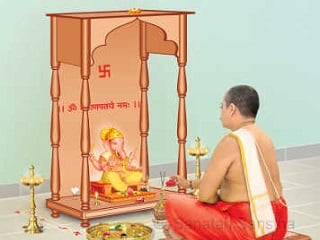
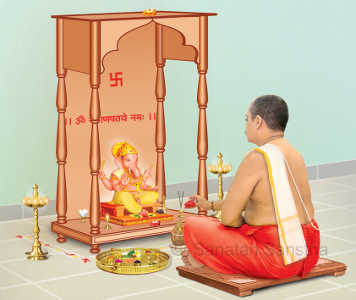
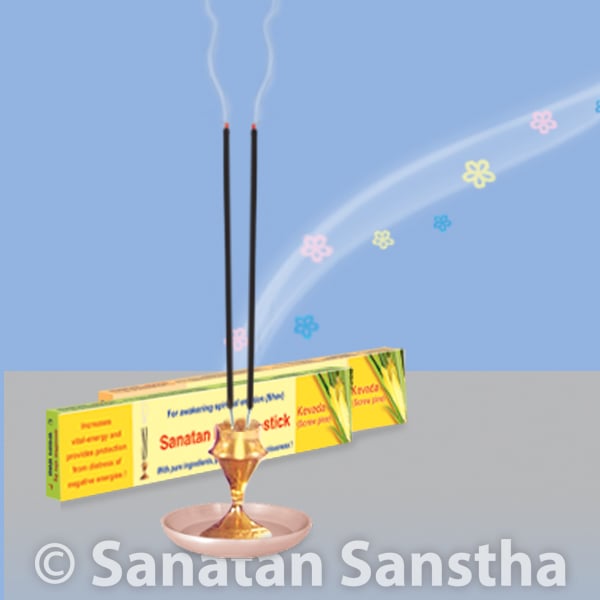
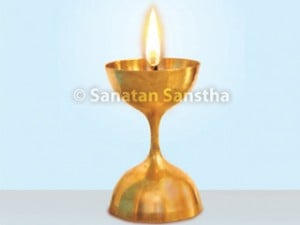
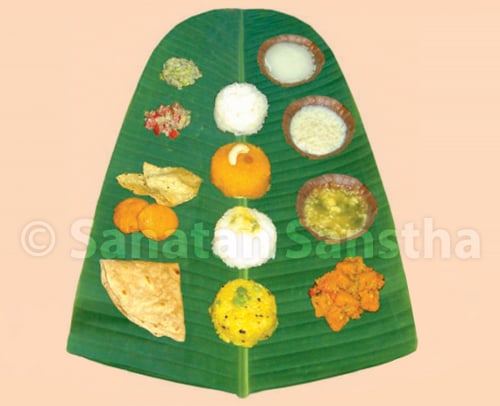
 Importance of Puja Samagri in ritualistic worship
Importance of Puja Samagri in ritualistic worship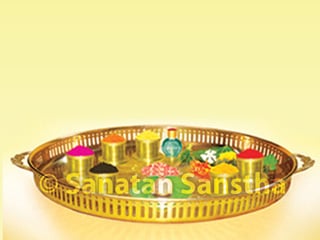 How to arrange the substances in Puja Thali ?
How to arrange the substances in Puja Thali ?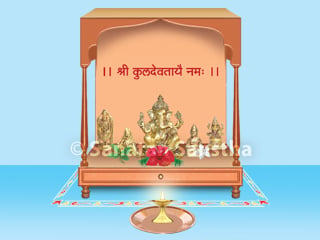 How should be the design of Devghar ?
How should be the design of Devghar ?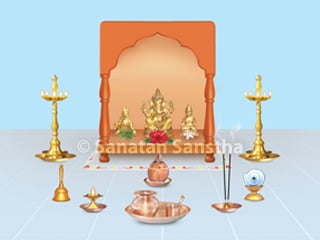 How to arrange the Puja items used in puja ?
How to arrange the Puja items used in puja ?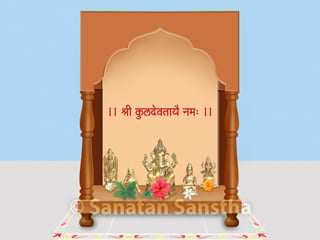 How to arrange Deities in Home temple ?
How to arrange Deities in Home temple ?